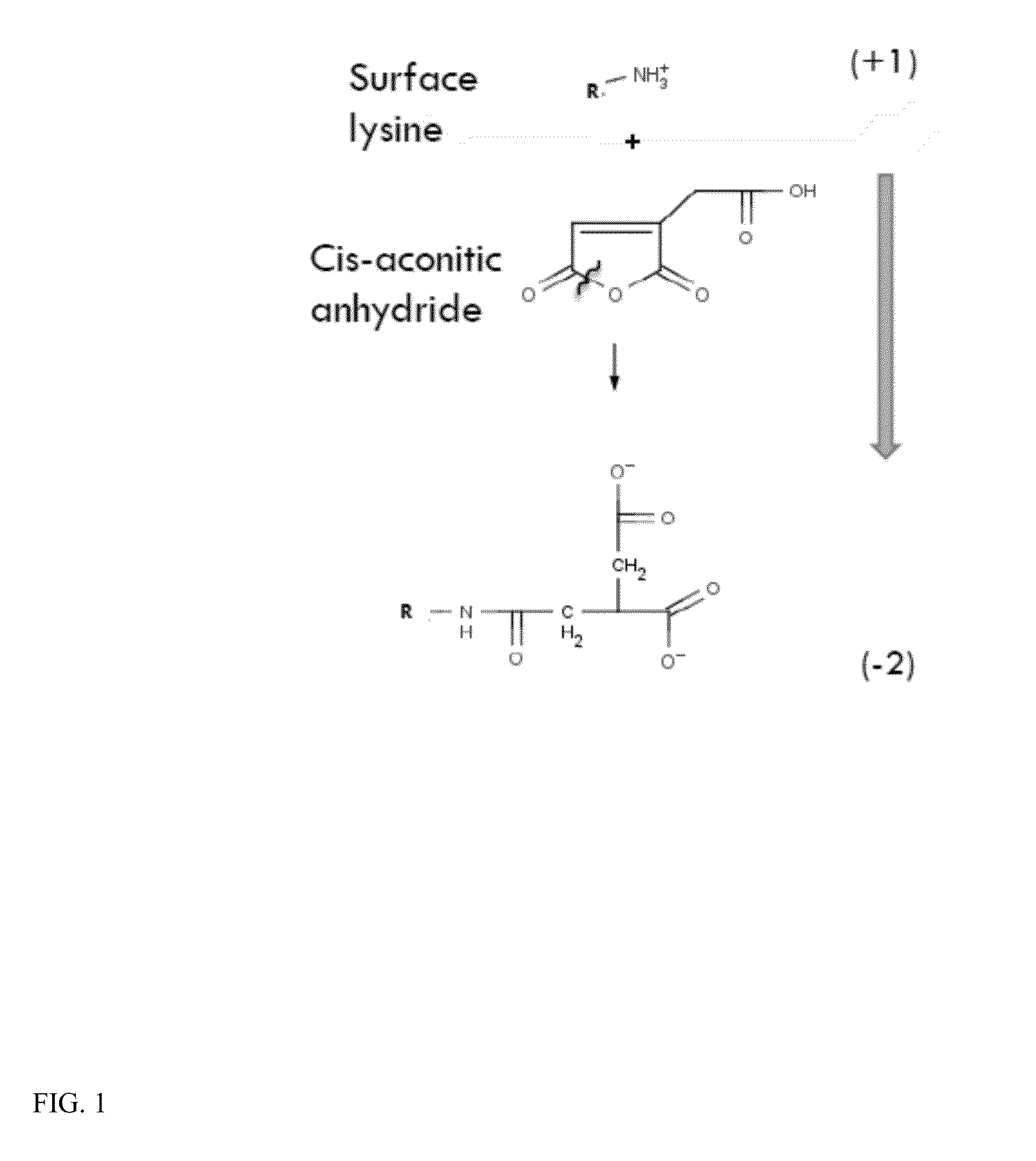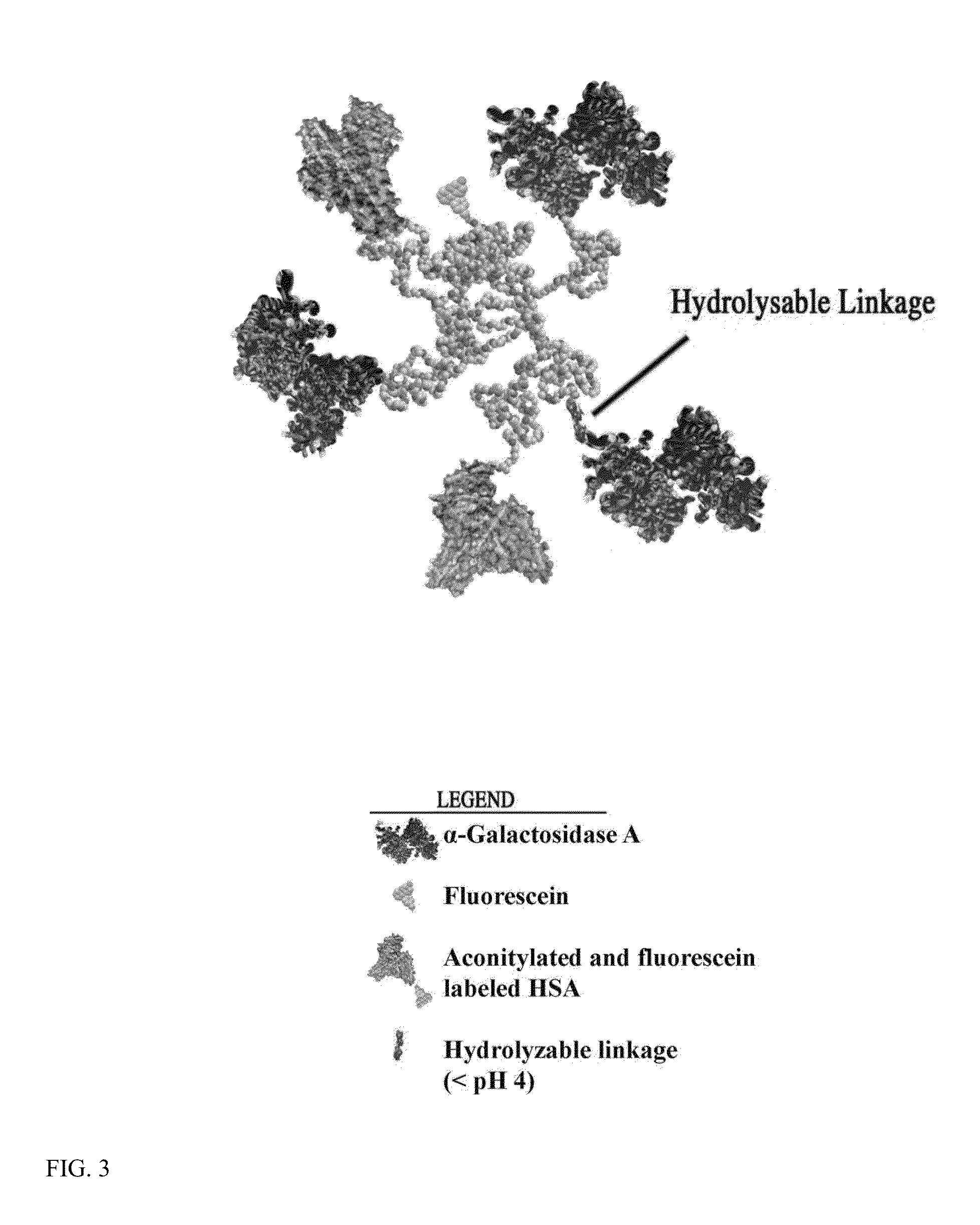Scavenger receptor uptake for fabry disease enzyme replacement therapy
a technology of fabry disease and enzyme replacement therapy, applied in the field of fabry disease enzyme replacement therapy, can solve the problems of burdensome treatment regimen, inability to meet the needs of patients,
- Summary
- Abstract
- Description
- Claims
- Application Information
AI Technical Summary
Benefits of technology
Problems solved by technology
Method used
Image
Examples
example 1
Reaction of Cis-Aconitic Anhydride with α-galactosidase A
[0105]A solution of enzyme (α-galactosidase A(α-Ga1 A)) was prepared at 1.35 mg / ml in 0.95 ml of Buffer A, pH 6.5 (110 mM NaHPO4, 0.22% NaN3, and 0.55 mM PMSF). To this was added 1 mg of cis-aconitic anhydride and stirred in the cold at 4° C. for 1.5 hr. The free anhydride was removed with a Sephadex G25 column.
[0106]Activity was measured using the artificial substrate MUG, with modification to use microtiter plates. Briefly, 10 ul of enzyme was mixed with 90 ml of enzyme assay buffer (5 mM MUG, 40 mM of sodium acetate buffer, pH 4.5) at 37° C. and incubated at 37° C. At 0, 10, 30, and 60 min, 10 ul was removed from the incubation mixture and added to 100 ml stop buffer of 0.1 M DAE (Sigma, catalog no. E-1521) in a microtiter plate and the fluorescence was read at excitation of 360 nm and emission of 460 nm. Activity was calculated by averaging the last two readings of the fluorimeter and dividing by the coefficient of the MU ...
example 2
Reaction of Cis-Aconitic Anhydride with HSA
[0108]The reaction is carried out in PBS buffer with 2 mg / ml HSA-fluorescein and 10 fold excess cis-aconitic anhydride at pH 8.5 at 25° C. for two hours. The aconitylated-HSA-fluorescein product was separated from free label with Sepandex G-25 chromatography.
example 3
Conjugation of α-galactosidase A to Fluorescently-Labeled Aconitylated-HSA (aco-HSA)
Fluorescent Labeling of HSA.
[0109]First, HSA was labeled with fluorescein. This reaction was carried out in PBS buffer with 2 mg / ml HSA and 20 fold excess NHS-fluorescein at pH 6.5 at 25° C. for one hour to give a low yield labeling reaction (F / P ratio 2 groups for aconitylation reaction. The HSA-fluorescein product was separated from free label with Sepandex G-25 chromatograhy.
[0110]Next, cis-aconitic anhydride aconitylation of HSA-fluorescein was done. The reaction was carried out in PBS buffer with 2 mg / ml HSA-fluorescein and 10 fold excess cis-aconitic anhydride at pH 8.5 at 25° C. two hours. The aco-HSA-fluorescein product was separated from free label with Sepandex G-25 chromatograhy.
α-Ga1A-PEG3300-Maleimide Reaction.
[0111]Next, α-galactosidase A is conjugated to PEG3300-maleimide. The reaction is carried out in PBS buffer with 2 mg / ml α-Ga1 A and 20 fold excess SM(PEG)8 (Pierce, catalog number...
PUM
| Property | Measurement | Unit |
|---|---|---|
| Composition | aaaaa | aaaaa |
| Therapeutic | aaaaa | aaaaa |
| Fluorescence | aaaaa | aaaaa |
Abstract
Description
Claims
Application Information
 Login to View More
Login to View More - R&D
- Intellectual Property
- Life Sciences
- Materials
- Tech Scout
- Unparalleled Data Quality
- Higher Quality Content
- 60% Fewer Hallucinations
Browse by: Latest US Patents, China's latest patents, Technical Efficacy Thesaurus, Application Domain, Technology Topic, Popular Technical Reports.
© 2025 PatSnap. All rights reserved.Legal|Privacy policy|Modern Slavery Act Transparency Statement|Sitemap|About US| Contact US: help@patsnap.com



